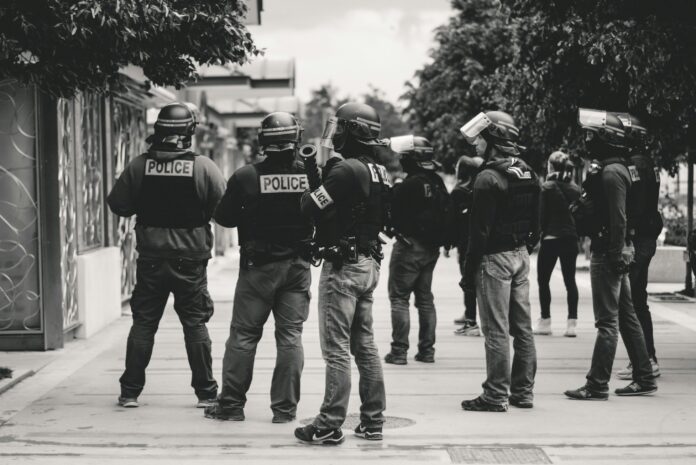On June 11, a week after a police training facility in Richmond, California, broke ground, organizers from the Stop Cop City Bay Area Coalition marched to the Overaa Construction headquarters in protest. Citing concerns over rising police militarization and repression in the predominantly Black and Latino area, the protesters—joined by local residents—called on Overaa workers to boycott the $30 million construction deal.
“By furthering the militarizing and surveillance of our city—and coordinating law enforcement resources across the region, including ICE [Immigration and Customs Enforcement]—they’re actually making our cities into Cop Cities,” said Refilwe Gqajela, a community organizer with the Anti Police-Terror Project in California’s Bay Area.
Gqajela said organizers in Northern California have been working to form the coalition since the facility was announced in August 2023. They’ve expressed their opposition at rallies and town halls, saying the money should instead be put into other programs that would benefit the community.
Of course, California isn’t the only state where Cop Cities are being built. The term first captured national attention in January 2023, when Manual “Tortugita” Teran was killed by police while protesting the Atlanta facility that’s displacing one of the largest urban forests.
The influx of these facilities parallels the emergence of the Defund the Police movement, which—following the murder of George Floyd in 2020—saw thousands of people across the country mobilize to decry police violence against Black and Brown communities. Within the last five years, there has been a quiet rollout of more than 80 multi-million dollar Cop City-like facilities across the country.
This development is raising concerns with anti-police organizers, especially when it comes to the impact on marginalized communities and movements. There is now a facility in almost every state and, according to researcher and mutual aid organizer Renee Johnston, at least 10 states have multiple police compounds.
“This nonsense with ‘the training needs to improve’ has been on a slow incline,” Johnston said. “2020 marks that period where, if we’re looking at a graph, there would be a sharp uptick in how quickly [Cop Cities] were going up.”
Groups like Stop Cop City Atlanta, Stop Cop City Dallas, and Stop Cop City Bay Area have been fighting these new police facilities in their communities by way of canvassing, holding rallies, petitioning, and more—similar to the effort in California.
At least seven cities, including Chicago and Baltimore, have allocated more than $100 million to their Cop Cities—and many are meant to host international police training programs like the Israeli occupation forces. Activists and scholars have said that Cop Cities are replicated after Israel’s own Cop City, “Little Gaza,” where they “battle-test” violence against Palestinians. This would be an expansion of already existing police training exchange programs that many U.S. states and cities have with Israel.
“We’re told that police are here to serve and protect the public and they care about the community, but I just don’t think any of that is true,” Johnston said. “That’s why training doesn’t work, because there is no training that you can give that’s going to change the nature of a system.”
While Cop Cities have been rolled out largely under the radar, activists around the country have been vocal about their opposition. Many have decried the multi-million dollar allocations to policing, and called on their local leaders to instead invest in resources needed by their communities.
Divestment From Police, Investment in Communities
Tennessee lawmakers are throwing $415 million into their Multi-Agency Law Enforcement Training Academy, an 800-acre facility to be built in a historically Black Nashville neighborhood currently experiencing a housing crisis, extreme displacement, and gentrification, according to Erica Perry, executive director of Nashville’s Southern Movement Committee.
“$415 million is a huge amount of money, especially in a state where we ranked low in health, literacy, education, and housing,” Perry said. “That’s extremely frustrating because we know that money could be spent on things that would help people have healthy, thriving, safe lives.”
In response, the Southern Movement Committee began advocating for a proposed $10 million investment in the creation of an office of youth safety, community centers, and alternatives to police in schools—programs they say the community actually needs. In June, $1 million of this budget was approved by the Nashville City Council.
“We’re trying to approach our budget work in a way that addresses safety and creates alternative forms of safety that do not require cops, courts, and cages,” said Southern Movement Committee Arts and Culture Director Mike Floss.
Activists in Chicago have shared similar concerns. In the years before the planning of its Cop Academy in 2017, the city had seen the closure of half its mental health clinics, as well as the then-largest sweep of school closings in U.S. history. Naturally, many residents were outraged when the new multi-million dollar police training facility was announced, especially considering the Chicago Police Department already had seven other training facilities in the area.
“Why is there suddenly this new investment available, when we were told that the city was broke when we were asking for investments in our own communities?” asked Benji Hart, an adult ally with the youth-led No Cop Academy Coalition.
Chicago’s Cop Academy came after the police-killing of 17-year-old Laquan McDonald, who was shot 16 times by a Chicago police officer in 2014. Not long after, youth organizers from the Stop Cop Academy campaign began spreading information by canvassing and passing out fliers, as well as leading more disruptive actions like taking over trains in large groups chanting, passing out flyers, and talking to other passengers about the campaign. They also blocked city council building elevators. Eventually, they grew the effort into a coalition of more than 100 local organizations.
“The initial thought was that there has to be a challenge to this narrative,” Hart said. “It can’t just be that the city announced it was going to build this thing. There needed to be some evidence of pushback and opposition to the construction, and calling for different funding priorities on the part of the city and for investments in community resources.”
For many organizers, the work is about making it known that crime isn’t the biggest threat—it’s houselessness, rising rents, food deserts, and the myriad other issues plaguing communities competing for funds with Cop Cities.
“The safest communities in the United States are not the communities that are over-policed,” said Kamau Franklin, a lead organizer with the Stop Cop City movement in Atlanta. “They are the communities that have resources that benefit the young people in their communities, that give people outlets, and make sure schools are satisfactory and building your mind. Those are the ways in which these resources could and should be used.”
Repression of Movements
Within the last two and a half years, local activists have been leading the Stop Cop City movement in Atlanta through canvassing, demonstrations, rallies, town halls, and creating petitions that garnered more than 116,000 signatures, growing the mobilization into a national conversation.
They’ve faced pushback from the other side. Dozens of Atlanta organizers have been jailed and charged with domestic terrorism and racketeering. According to Franklin, this a coordinated effort to criminalize activism and scare organizers. He said a large part of the facility will be built by the end of the year, even though a poll from 2023 indicated that 59% of residents don’t support it.
Over the last year, repressive policing has extended beyond Stop Cop City organizers to encompass Gaza solidarity student encampments as well. Tamera Hutcherson, an organizer with Stop Cop City Dallas, said the city council held secretive meetings and used vague language around “public safety” to get voters to support a proposition that gave $50 million to a police training facility. Soon after, Texas State Troopers raided a peaceful Gaza solidarity student encampment.
“For students peacefully protesting, they came in riot gear and in tactical gear, they looked like they were ready for war against civilians,” Hutcherson said. “I think most residents are concerned about what this means, not just for the city of Dallas, but for Dallas county and North Texas as a whole.”
While Hutcherson said there are still not many people in Dallas who are aware of the facility being built, she is starting to see more conversations happen as organizers continue canvassing, going door-to-door, and making phone calls to community members.
“Not just in Atlanta, but around the country, the militarized police are on full display, meant basically to derail and destroy movements, to scare people,” Franklin said. “Cop City is a way for them to organize that policing and practice those tactics and strategies even more so.”
In the Bay Area, Refilwe Gqajela said activists have faced increased police and city council repression amidst their efforts to host rallies and town halls. For example, when residents attended city council meetings to speak out about Cop City, the normal three-minute public comment period would be cut down to one minute. The San Pablo Police Department also shut down one of their attempted town halls at Costa County Community College. Nevertheless, Gqajela and others have continued to organize.
“We understand this to be a direct threat to our organizing—this is a state repression tactic,” Gqajela said. “We know that this isn’t just going to impact the people of San Pablo. It’s a regional training facility to organize the policing forces in the Bay Area to squash the kind of organizing that’s being done right now for Palestine, for example.”
The Movement Continues
Activists vow to continue their advocacy, despite the pushback. Along with Black Youth Assembly, the Southern Movement Committee has been meeting with Nashville city officials to get their Varsity Spending Plan on the city council’s radar.
“It’s our work to help people see what is happening—when it comes to their health and education needs—is connected to the state’s insistence on spending $415 million on this campus,” Perry said.
As the organizers with Stop Cop City Dallas continue to strategize and mobilize, Hutcherson said that she sees the mobilizing of students across the University of North Texas system as a victory. Four of the five campuses have formed a Stop Cop City coalition of their own to pressure administrators to back out of the partnership with the Dallas Police Department through protests and organizing.
“We are continuing to educate the public, and also figure out and strategize ways to continue applying pressure to ensure that this is not built,” Hutcherson said.
The organizers with the Anti Police-Terror Project and the coalition in the Bay Area have been holding town halls and rallies to stop their Cop City from being built—and teachers, students, environmental activists, residents, and health care workers have been mobilized to join the cause. They’ve also been organizing alongside the Ohlone people, who are native to Northern California where this project is being built and have been decrying a Cop City being built on their land.
In Chicago, activists were able to delay the Cop City project, but not its eventual construction. Undeterred, Hart said that some of the youth organizers involved in the No Cop Academy coalition successfully campaigned for a $21 million cut from Chicago public schools’ contract with the Chicago Police Department, which eventually led to the contract’s end.
Around the country, activists and organizers have been building solidarity with the struggle in Atlanta and other states, as well as Palestine. As Hart noted, solidarity is important during this “clear orchestrated push for militarization and hyper investment in police—in the wake of arguably the largest protests in U.S. history calling for the defunding of the police.”
“We need to be supporting each other across city and state lines, and not just treating these as a bunch of little battles against individual Cop Academies or Cop Cities,” he said. “Our response needs to be as orchestrated as the police state’s response to our organizing.”
This story originally appeared at Waging Nonviolence, and is reprinted here under a Creative Commons license.
This article originally appeared in Yes! Magazine at https://www.yesmagazine.org/social-justice/2024/10/04/atlanta-police-cop-city-resistance.
Yes! Magazine is a nonprofit, independent media organization dedicated to telling stories of … . Learn more at Yes! Magazine
Image: unslash



































